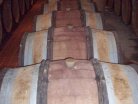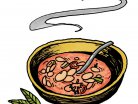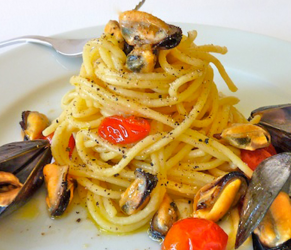Their workstations are the hot, flour-dusted corners behind the store. The accoutrements of their trade are those that one might expect to see in a baker's back room: an industrial-size oven (sometimes wood-burning) and a huge metal mixer, chugging along in the late afternoon as it makes the malleable dough. Here and there lean sacks of flour, and on racks sit the long, shallow wooden trays where the little mounds of dough have been left to rise, before they will be moved to the marble counters covered with flour. There, the dough balls are coaxed open by the master's s quick, light fingertips.
Within arm's reach are all the necessary accessories; blocks of kasseri cheese and a few odd pieces of kefalograviera. Once grated, they are mixed with water into a milky paste and set in a deep basin, ready in wait to be spread onto the dough. The water will keep the cheese from burning in the oven. In preparation for the orders that are soon to be coming in, stacks of eggs and containers of ham, bacon, sausage, ground meat, and, of course, pastourma are lined up nearby. Once the orders arrive, the dough will be filled, its lips folded over, and its corners pinched.
Then finally, it will take on its characteristic boat shape and be placed into the oven. Even the heat is a matter of secret concern. Some people say the ovens have to be medium-hot, around 180 degrees. Others will swear by more heat. When the dough boat finally comes out of the oven, its hot crust is shamelessly slathered with huge slabs of butter. With that, the peinirli enters the world.
This sating, seemingly easy-to-make concoction of yeast dough, cheese, and myriad filling choices is an old-world snack that most seasoned pros will tell you takes years to perfect. Peinirli came to Greece in the early 1920s, with the refugees from Asia Minor. The word, of course, is Turkish and translates roughly to “cheese.” A plethora of regional variations exist throughout Turkey and the Caucasuses. Similarly, in Istanbul, the peinirli is not boat-shaped but round and thin. The boat shape seems to have its origins in Greece, and perhaps developed simply for practical purposes. The peinirli can be found in the form and shape described above in bakeries throughout Athens, but most prominently in the Drapetsona and Drossia regions of the metropolis.
The Old-World Peinirli
Comprised of dough, cheese, and myriad filling choices, "peinirli" is a sumptuous old-world snack that came to Greece in the early 1920s from Asia Minor.
Country:
Category:
Related Articles
Most Popular recipes



































































